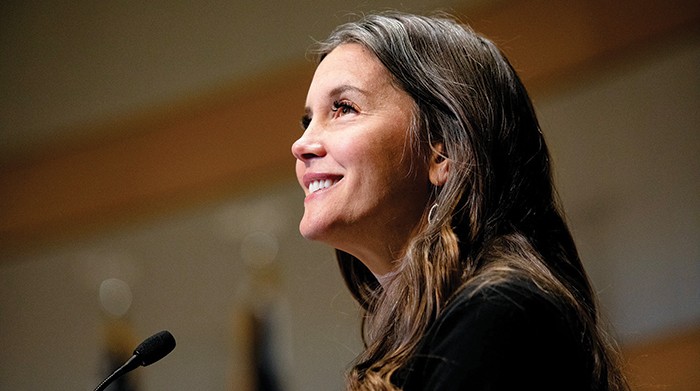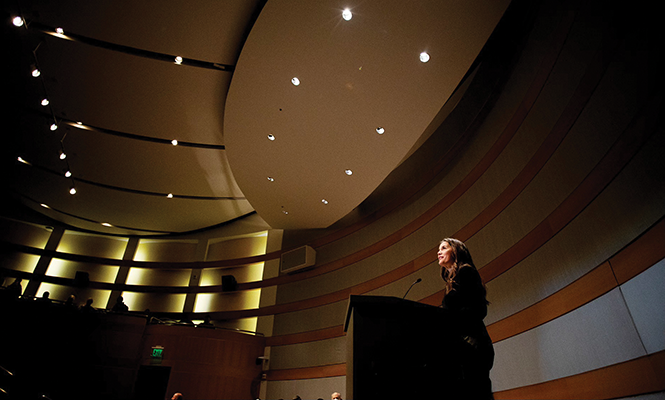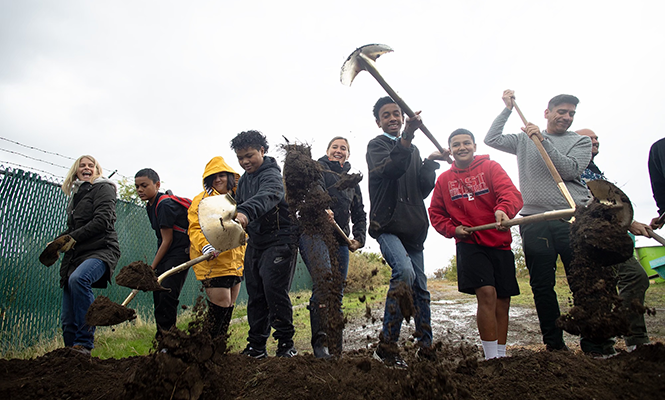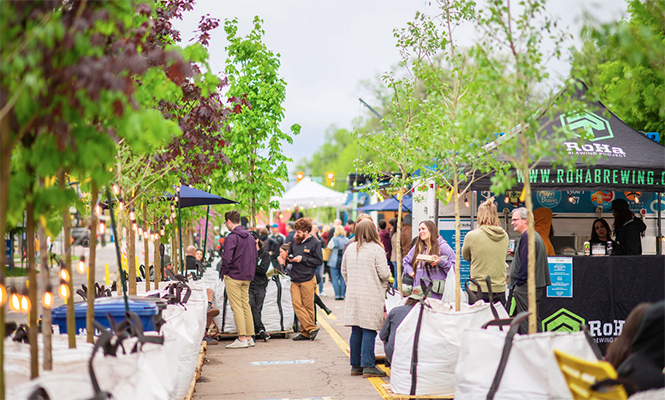SLC Mayor Erin Mendenhall on her reelection victory, working with the Utah Legislature and the 'unrivaled' opportunities of the next decade.
Steady as She Goes
By Benjamin Wood @BjaminWoodErin Mendenhall began her second term as Salt Lake City mayor on Jan. 2, ringing in the new year with a swearing-in ceremony at downtown's Main Library.
While her first term was punctuated by a pandemic, a deepening housing crisis and the occasional force majeure, her second promises to be no less eventful, with new investments in parks and public transportation, with the departure of the Salt Lake Bees baseball to Daybreak and the potential departure of the Utah Jazz to Draper (really? ... Draper?) and with the state of Utah staring down the barrel of a second Winter Olympic Games in 2034.
On top of all that, lawmakers are once again convening on Capitol Hill at the end of January, poised for election-year grandstanding and ever wary of letting the capital city step too far out of line.
City Weekly caught up with Mendenhall to get her lay of the land on those topics, her goals for a second term and her vision for the future of Salt Lake City. Her responses, received via email, were edited for length and clarity.
City Weekly: You won reelection with a comfortable majority against a well-known opponent. Did the vote align with your expectations for the race?
Mayor Erin Mendenhall: Every day, I get to interact with Salt Lakers, the owners of our small businesses and community leaders. They care deeply about this city. They love living and working in our community.
Like all cities, we have areas we can and must improve and grow—but that doesn't discount the beautiful and caring community we live in. I think the election was proof that many residents feel this way and want us to continue working with them—with partners—on solutions rather than fighting and trading insults.
CW: What did you learn during your first term that will help you navigate your second?
EM: I learned Salt Lakers and this city are incredibly resilient; we navigated a pandemic, earthquakes, a windstorm, protests and flooding. Each brought us different challenges, insights and opportunities to grow stronger than ever before.
Time and time again, I saw people come together in tough circumstances to support, listen and learn from one another. Seeing this level of connection was inspiring, and it's stayed with me.
I know we can achieve more when we work together and when we stay at the table, genuinely hungry to find solutions to our greatest challenges.
We don't have to always agree—we can disagree in productive ways and learn a lot from each other. We've made this our approach with the community, the state and other partners we need to work with to get real results.
CW: You've spoken about the potential for burying rail lines and redeveloping land in and around the Depot District. Have the new cost projections ($3 billion to $5 billion) changed your thinking and/or attitudes toward that proposal?
EM: Our west side residents are too familiar with the physical infrastructure barriers—including the rail lines and interstate—that have physically divided our city for generations. The city is working to increase east-west connectivity through different policies and planning.
We received a $1.9 million grant from USDOT through Reconnecting Communities. We've updated our citywide transportation plan, Connect SLC, with a strategy to help heal the east-west divide.
In 2023, the 300 North Pedestrian Bridge officially opened, creating more safe and accessible walkways and bikeways for Salt Lakers. That street crosses five rail lines, which has disproportionately impacted west side residents, especially our youth crossing to West High School. The pedestrian bridge is only the start of our journey to increase connectivity, equity and safety.
The execution of a project of this size and complexity, like burying the rails and redeveloping the land, will require significant investment from state, federal and private sector partners. Like residents, my administration wants to determine realistic avenues and funding mechanisms to remove these barriers that divide our city.
CW: What are your administration's priorities heading into the legislative session?
EM: Gov. Spencer Cox's budget proposal for fiscal year 2025 could provide significant investment in affordable housing, mental and behavioral health, emergency shelter services and additional resources for people experiencing homelessness. The proposals he outlined could positively impact Salt Lake City and our overall quality of life for generations to come. These issues are important to my administration and critical to solving our regional issues related to the housing crisis and the rise of unsheltered Utahns.
In addition to housing and homelessness, I hope to see the Legislature advance family-centric policies, including childcare and legislation that supports environmental quality and the stewardship of our scarce resources. We are far from out of the woods when it comes to securing a healthy Great Salt Lake ecosystem, and I am hopeful that state leaders will continue to move forward on statewide conservation efforts and decisions to support future generations of Utahns.
CW: What will it take and what is being done to turn the corner on homelessness?
EM: We know at the root of this nationwide increase in people experiencing homelessness is a lack of affordable and deeply affordable housing. We need more affordable units and more resources for our most vulnerable communities experiencing homelessness, not just in Salt Lake City, but all across Utah.
In the past two years, there have been more coordination and early planning for winter shelters and resources than have been seen in recent years. Sandy is home to a new medically vulnerable population (MVP) facility that will house up to 165 individuals experiencing homelessness. West Valley City is hosting a winter overflow shelter for the first time ever.
In partnership with the Utah Office of Homeless Services, a temporary micro-shelter community is up and running for the first time, providing support to 50 individuals in a non-congregant shelter setting. This temporary pilot will inform the state's operation of a permanent micro-shelter site to come in 2024.
We know that Salt Lake City alone cannot turn the corner on homelessness. It will take all levels of government, partners and providers continuously coming together to provide solutions that meet people's complex needs so that homelessness becomes rare, brief and nonrecurring. I want to build on the solutions and partner-based initiatives that we helped bring to life this past year so we can continue to safely shelter and house more people in need.
CW: Is the state taking the threat of air quality and a declining Great Salt Lake seriously enough?
EM: I'll be the first to say that I wish it all were happening faster. But I also see firsthand that change is happening. Our city cannot save the Great Salt Lake on our own any more than we can single-handedly clean all of Salt Lake Valley's air. Saving the Great Salt Lake is going to take all of our work, but especially the state.
We will take the same approach on the Great Salt Lake and air quality—do everything we can as a city, do more, and then work with our partners instead of against them.
Salt Lake City has redoubled our commitment to cleaning the air and protecting our namesake. We will keep conserving water and looking for new ways to reduce consumption. We'll keep working to protect our annual 13-billion-gallon contribution to the lake. We'll be proactive in sharing our best practices and also take every opportunity to advocate for statewide solutions.
CW: Most of the state's leadership live outside of Salt Lake County, let alone Salt Lake City. What would you want the typical Utah lawmaker to understand about Salt Lake City?
EM: We're proud to be Utah's capital city and the hub of business, entertainment and sport. A strong capital city is good for the entire state of Utah.
We've made it part of our city's fabric to be welcoming to the many diverse people who call this place home or are passing through.
We are creative. We are collaborators. And we're using these parts of our identity to further the well-being of both our economy and environment.
At the end of the day, I believe the capital city and other municipalities in Utah do have a great deal in common. Many people want to live in safe, welcoming communities that provide realistic avenues to housing, economic opportunity and connections to their neighbors and loved ones. We're here to work and find common roadways to move forward, together.
CW: What still needs to be done for the city and state to be ready to host the 2034 Olympics? And what do you say to residents who remain skeptical of hosting the event?
EM: In so many ways, we're ready now. Across the state, facilities have been maintained since the 2002 Winter Games and will likely need very little retrofitting. It's part of what's made our bid so unique and strong.
I've been working on this since my first two months in office, when we created the Salt Lake City-Utah Committee for the Games. What we'll create and prioritize in the next 10 years is all about building a community-centered experience. And what we decide to build in the next four years will set the stage for the legacy of the 2034 Games: more parks and open space; public art; public transit; and more places where the community can come together and thrive.
While 80% of Utahns support us hosting the Games, I'll say to those still skeptical: venture to volunteer. Maybe you didn't live in Utah in 2002—maybe you weren't born yet! But for those of us who did, it was the most powerful experience of community. I want you to get to feel that, too. Especially our kids.
This global event will bring people from hundreds of nations right to our city and allow our youth a rare opportunity to experience an unmatched level of competition, diverse cultures and unity. The Olympics and Paralympics will undoubtedly inspire the next generation of leaders in Salt Lake City.
CW: What were some of your favorite SLC events in 2023 and what are you looking forward to in 2024?
EM: It felt like Salt Lake City was truly buzzing, from entertainment events to sports to music to festivals, all year long. I really enjoyed the new drone shows at our parks for the Fourth of July and Pioneer Day; I think it was just the beginning of creating new and exciting ways to celebrate our history with our families while looking to the future. I hope you didn't miss out, but if you didn't catch them, be on the lookout this year.
I also loved getting to experience Outdoor Retailer back in action in Salt Lake City in 2023 and what small businesses are doing to innovate in sustainable ways that I think will push bigger retailers to adapt. It's exciting to see that unfold right here in our downtown.
There's so much to look forward to this year. I hope more Salt Lakers will join me for bike rides to work on new paths across the city. The group rides are so much fun, whether you're a regular or just acquired your first bike at the Bicycle Collective's new shop.
I think one of the biggest events I'm looking forward to, though, in 2024 will coincide with the Paris Summer Olympics—that's when the International Olympic Committee (IOC) will officially name the hosts for the 2030 and 2034 Winter Games.
CW: What does Salt Lake City look like one decade from now, and how is your administration working toward that vision?
EM: This time right now is unrivaled in our city's history. There are four historic threads intersecting with breathtaking complexity: the preparations for the Olympic and Paralympic Games; the determination of the long-term future of the Utah Jazz and the pursuit of Major League Baseball and National Hockey League franchises; the construction of Glendale Regional Park and the momentum behind a downtown green loop; and the ongoing record investments in housing construction in our city with massive city investments in wealth building for renters and homeowners.
My administration is working together with residents, with partners and with other levels of government so that our future doesn't happen to us, but rather it happens with us and because of us. Tune in to State of the City on Jan. 30 to hear more.
More by Benjamin Wood
-
UTA exploring contractors for extra services, but will keep running Ski Bus in-house, spokesman says.
Suss Bus
- May 1, 2024
-
Elementary students and Mayor Mendenhall plant trees at Salt Lake City's new 9-Line Orchard
Fruit by the Foot
- Apr 30, 2024
-
‘Festival street,' Green Loop and transit-oriented density anchor latest SLC plans for west downtown.
Arrested Development
- Apr 17, 2024
- More »
Latest in Cover Story
Readers also liked…
-
Forget the family pedigree—Robert F. Kennedy Jr should not be the next president of the United States
Trojan Horse
- Jun 21, 2023
-
Women decry harassment and toxic culture at St. George auto dealership
Men at Work
- Oct 11, 2023







